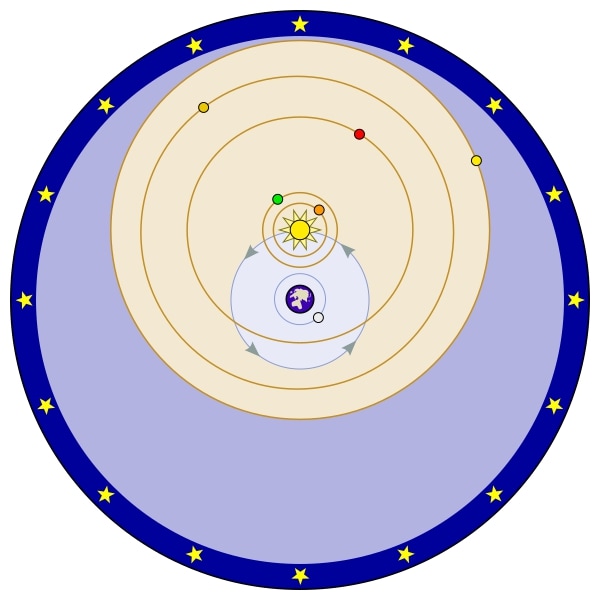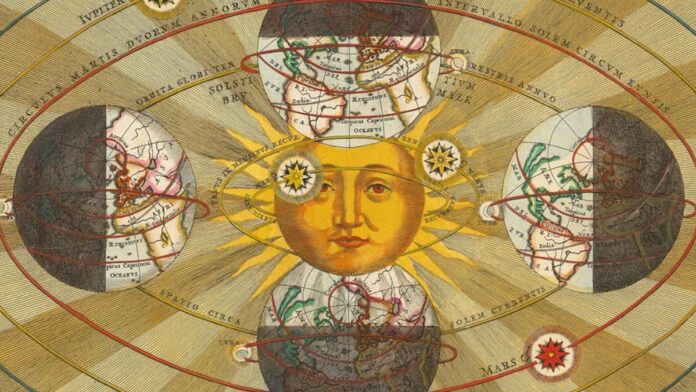Copernicus was not the first who claim that the Earth rotates around the Sun. Before Copernicus, many ancient astronomers claimed the same, and some also gave mathematical and theoretical explanations that how the Earth Rotates from and how the earth rotates on its axis. Indian scholars, astronomers, and mathematicians Aryabhatta, Brahmagupta, and Yajnavalkya discovered that the Earth is round and rotates on its axis much before Copernicus. Then, Aristarchus proposed a Sun-centered astrological hypothesis of the universe in modern civilization.
Aristarchus’ hypothesis was less recognized, but after 18 centuries, astronomer Galileo constructed an entirely predictable simulation of a planet’s orbit. This article teaches how great astronomers and mathematicians, through centuries, predicted and explained how Earth rotates from and around the sun.
In The Ancient Times
Aryabhatta and Brahmagupta’s explanation of How the Earth Rotates
Thousand years before Galileo, the Indian scholar aryabhatta had mentioned clearly in the audAyaka system that the days were counted from uday.” Some of his later astronomical papers, which appear to propose a second model (or Ardha-ratrika, midnight), are lost, but the discussion in Brahmagupta’s Khandakhadyaka can be somewhat reconstructed. He seemed to attribute the apparent motions of the heavens to the Earth’s rotation in several works. He might have thought the planet’s orbits were elliptical instead than circular.
In contrast to the then-prevailing belief that the sky rotated, Aryabhata correctly asserted that the earth rotates on its axis daily and that the apparent movement of the stars is a relative motion caused by the rotation of the Earth. In the first chapter of the Aryabhatiya, where he gives the number of yuga rotations and is more explicit in the gola chapter:
४.९.१ अनुलोमगतिर्नौस्थ: पश्यत्यचलं विलोमगं यद्वत्।
४.९.१ अचलानि भानि तद्वत्समपश्चिमगानि लङ्कायाम्॥
४.१०.१ उदयास्तमयनिमित्तं नित्यं प्रवहेण वायुना क्षिप्त:।
४.१०.२ लङ्कासमपश्चिमगो भपञ्जर: सग्रहो भ्रमति॥
“Someone on the equator sees the fixed stars going uniformly westward, just as someone in a boat moving forward sees a stationary object moving backward. The rising and setting of the Sun are caused by the fact that the sphere of the stars, along with the planets, appears to turn due west at the equator, pushed by the cosmic wind.”
३.१५.१ भानामध: शनैश्चरसुरगुरुभौमार्कशुक्रबुधचन्द्राः ।
३.१५.२ एषामधश्च भूमिर्मेधीभूता खमध्यस्था॥
४.६.१ वृत्तभपञ्जरमध्ये कक्षापरिवेष्टित: खमध्यगत:।
४.६.२ मृज्जलशिखिवायुमयो भूगोल: सर्वतो वृत्त:॥
“According to Aryabhata’s geocentric solar system model, the Sun and Moon are each carried by epicycles; they, in turn, revolve around the Earth. In this concept, the planets’ motions are governed by two epicycles, a smaller manda(slow) and a larger śīghra(rapid), which is also found in the Paitmahasiddhnta. The order of the planets in terms of distance from Earth is taken as the Moon, Mercury, Venus, the Sun, Mars, Jupiter, Saturn, and the asterisms. The sphere of the Earth, made of Earth, water, fire, space, and wind, sits amid space, within the cage formed by stars and encircled by orbits.”
The planets’ locations and periods were computed about uniformly moving points. Mercury and Venus, for example, orbit the Earth at the same mean speed as the Sun. Mars, Jupiter, and Saturn orbit the Earth at different rates, representing the motion of each planet through the zodiac. Most astronomy historians believe that this two-epicycle model reflects pre-Ptolemaic Greek astronomy. Some historians believe the ghrocca, or essential planetary time about the Sun, hints at an underlying heliocentric concept in Aryabhata’s model.
Aryabhata scientifically explained solar and lunar eclipses. According to him, the Moon and planets are illuminated by reflected sunlight. He explains eclipses in terms of shadows thrown by and falling on Earth rather than the prevalent cosmogony in which eclipses are caused by Rahu and Ketu (designated as the pseudo-planetary lunar nodes). As a result, a lunar eclipse occurs when the Moon passes through the shadow of the Earth (verse gola.37). He goes into great detail about the magnitude and extent of the Earth’s shadow (verses gola.38–48) and then explains how to calculate the size of the obscured portion during an eclipse.
Later Indian astronomers improved on Aryabhata’s calculations, but they were the foundation. During a visit to Pondicherry, India, in the 18th century, 18th-century scientist Guillaume Le Gentil discovered that Indian computations of the duration of the lunar eclipse of August 30, 1765, were short by 41 seconds, while his charts were extended by 68 seconds.
Aryabhata calculated the sidereal rotation (the Earth’s orbit based on fixed stars) to be 23 hours, 56 minutes, and 4.1 seconds in contemporary English units of time; the modern figure is 23:56:4.091. Similarly, his value of 365 days, 6 hours, 12 minutes, and 30 seconds (365.25858 days) for the length of the sidereal year is an inaccuracy of 3 minutes and 20 seconds over a year (365.25636 days).
As previously described, Aryabhata advocated an astronomical concept in which the earth rotates on its axis. In terms of the mean speed of the Sun, his model also provided corrections (the gra anomaly) for the rates of the planets in the sky. As a result, it has been proposed that Aryabhata’s calculations were based on an underlying heliocentric paradigm, in which the planets orbit the Sun, although this has been refuted, and been suggested that some features of Aryabhata’s theory were borrowed from an earlier, presumably pre-Ptolemaic Greek, the heliocentric model that Indian astronomers were unaware of, however evidence for this is limited.
Let’s look thoroughly at Aryabhata’s writings. We can conclude that at a time when most people believed in the Ptolemaic view solar system, He was the first to propose that the stars were immobile and that the Earth’s daily motion drove the movement of the sky. However, he did not elaborate on how he came to this decision. He had begun rejecting the prevailing Ptolemaic viewpoint, but his successors did not carry it out; therefore, nothing came out of it.
Many individuals claim that Aryabhata held the heliocentric view in mind, according to which the Sun is fixed and the planets, including the Earth, revolve around it in orbits. However, we have not found any convincing evidence to support this claim. We ask any member aware of it to email us in response and let us know. Therefore we concluded that according to the consensus, Aryabhata’s system was not explicitly heliocentric.
Aristarchus of Samos (3rd century BCE) is credited with holding a heliocentric theory. Still, the version of Greek astronomy known in ancient India as the Paulisa Siddhanta does not refer to such a theory. A synodic anomaly (depending on the position of the Sun) does not imply a physically heliocentric orbit (such corrections are also present in late Babylonian astronomical texts).
The idea that the Sun, rather than the Earth, is at “the center of the spheres” can be traced back to the Indian philosopher Yajnavalkya (9th Century BCE); he was a follower of the Vedic Tradition, which included the use of mathematics and geometry in religious rites and was a crucial character in early Indian astronomy. In the Satapatha Brahmana(Shatapatha Brahmana: 8.7.3.10), he discusses a 95-year intercalary cycle to balance the lunar and solar years and the Sun’s non-uniform motion. Yajnavalkya mentions as:
द्वादिं सतं वै देवरथहन्याम लोकस्तं सामंतम पृथ्वी द्विस्तवतपर्यति तमसमंतम पृथ्वी द्विस्तवत्समुद्रा पर्यति।
“Thirty-two times the place covered by the chariot of the Sun in a day makes this vimana (Loka); around it, covers twice the area of the world (Prithivi); Around the world, covering twice the area, is the ocean.”
“The sun strings these worlds – the earth, the planets, the atmosphere – to himself on a thread.”
This is one of the first recorded references to heliocentrism. Still, supporters of the idea were in the minority, and India continued to believe in a geocentric model until the telescope was invented in the 17th century.
Aristarchus‘ explanation of How the Earth Rotates
During 310BC–230 BCE, our solar system was formerly thought to represent the whole known universe by most people around the world, with the Earth at its center and the rest of the planets and fixed stars circling it daily. The Sun, not the Earth, inhabited the center of the universe. Still, Aristarchus believed the stars to be other very far-off suns and thought there was no discernible parallax—a movement of the stars relative to one another as the Earth revolves around the Sun—as a result.
His accurate speculation was at the time unprovable since stellar parallax is only measurable with telescopes. Hence, his groundbreaking new idea is that while the Earth and the other planets orbit the Sun in a circular motion and the fixed stars and the Sun do not move, the Earth rotates around the Sun in a circle, with the Sun in the center.
Despite this, Aristarchus’s heliocentric thesis seemed counter-intuitive to the senses, so some philosophers, mathematicians, and scientists agreed with him. Seleucus of Seleucia (190–150 BC), who was born nearly four decades after the death of Aristarchus, is the only astronomer by the name known to do so.
Plato and Aristotle‘s explanation of How the Earth Rotates
The geocentric theory of the solar system—proposed by Greek philosophers like Plato (428–348 BCE) and Aristotle (384–322 BCE)—with the Earth at its center emerged as the most widely accepted explanation for celestial occurrences. Ptolemy (90-168 AD) cataloged the geocentric model in his masterpiece, “Almagest,” published in 140 AD. For the following 14 centuries, this theory was accepted in the western world until Nicolaus Copernicus came out with a new idea.
In The Modern Times
Copernicus‘ explanation of How the Earth Rotates
Before 1514, Copernicus made his “Commentariolus” (“Little Commentary”), a manuscript outlining his thoughts on the heliocentric theory, available to acquaintances. It has seven fundamental presumptions. He then kept compiling information for more in-depth work.
Although his closest friends urged him to do so, Copernicus resisted, saying that he did not want to risk the ridicule “to which he would expose himself on account of the novelty and incomprehensibility of his theses.” Copernicus had essentially finished writing the manuscript of De revolutionibus orbium coelestium by around 1532 and proposed an utterly predictable model of the cosmos in which the Earth is merely another planet orbiting the Sun in his major work. Still, he waited until his deathbed in 1543 to publish it for fear of being labeled a heretic by the Christian Church.
Although the Catholic church halted Copernicus’ book, pending revisions, and violently fought to suppress all arguments connected to his heliocentric theory at the time, the Copernican Revolution is now regarded as the starting point for modern astronomy. De revolutionibus was not officially forbidden by the Catholic Church until March 5, 1616, and Galileo used it to reinforce his heliocentric beliefs.
Giordano Bruno’s cosmological claims
After Copernicus, Bruno wrote two significant philosophical conversations in 1584 (La Cena de le Ceneri and De infinito universo et Mondi). He argued against planetary spheres and affirmed the Copernican principle. In 1586 and 1587, Christoph Rothmann and Tycho Brahe did the same.
In La Cena de le Ceneri, Bruno anticipates some of Galilei’s arguments on the relativity principle, and he also uses the example now known as Galileo’s ship to support the Copernican view and oppose the objection that the motion of the Earth would be perceived by the action of winds, clouds, and so on.
Christoph Rothmann and Tycho Brahe
An oft-quoted correspondence between Christoph Rothmann and Tycho Brahe encapsulated the physicists’ difficulty. Brahe was skeptical of Nikolaus Copernicus’ heliocentric view of the world; in a letter to Rothmann, he raised the following objection to the Earth’s movement: “if the Earth turns from west to east, then a cannonball fired toward the turning of the Earth must continue to fly as fast as a projectile fired in the opposite direction.” Rothmann responded that projectiles and cannons would participate in the Earth’s movement, rendering his objection moot. This, however, was counter to the Aristotelian view of motion prevalent in Europe at the time.

Galileo Galilei‘s explanation of How the Earth Rotates
After discovering Jupiter’s four main moons in 1610, the first satellites ever found orbiting another planet, Galileo Galilei (1564-1642) used the newly invented refracting telescope to further expand on Copernicus’ theory, and after observing the phases of Venus, he proved that the planets that orbit the Sun are, in fact, the planets. However, by 1615, Galileo’s writings on heliocentrism had been submitted to the Roman Inquisition by Father Niccolò Lorini, who claimed that Galileo and his followers were attempting to reinterpret the Bible. Galileo then wrote ‘The Dialogue Concerning the Two Chief World Systems in 1632, in which he contrasted the Copernican and Ptolemaic world systems, but was later condemned on “grave suspicion of heresy,” compelled to renounce his ideas and spent the rest of his life under house arrest.
Sir Isaac Newton‘s explanation of How the Earth Rotates
As soon as Sir Isaac Newton built the reflecting telescope in 1688, the Earth was not the center of our solar system. Newton’s Principia Mathematica, in which he fully demonstrated the heliocentric model initially introduced by Copernicus, was the last theory to falsify geocentrism. And thus, to support the heliocentric hypothesis, Edmund Halley (1656–1742) used Newton’s calculations to predict the comet’s return in 1758.
Conclusion
Aryabhatta’s writings show that he believed that the stars were fixed in their positions and that the Earth moves. Most experts believe that this motion is the daily motion of the Earth, in which the earth rotates on its axis from its north-south axis. It is also possible that this motion is the Earth’s annual rotation around the Sun, although no solid reasoning is available for this.
The Hellenistic astronomer Seleucus of Seleucia, who lived a century after Aristarchus, is said to have maintained and demonstrated heliocentrism as a definite opinion. However, no complete record of the performance has been found. Aristarchus proposed heliocentrism only as a hypothesis. Pliny the Elder later questioned whether the displacement of the Earth from its central position could be the reason for the inaccuracy in his predictions of the heavens in his Naturalis Historia. It is implied by heliocentrism rather than geocentrism that Pliny and Seneca describe some planets’ apparent (and untrue) phenomenon of retrograde motion. The geocentric model, accepted as accurate in the Middle Ages, was supported by Plato, Aristotle, and Ptolemy, even though no stellar parallax was ever observed. Aristarchus also concluded after realizing that the planets revolve around the Sun, i.e., how big the Sun would be from Earth and other planets. However, it turned out that this profound revelation was “too much for the philosophers of the time to digest, and astronomy had to wait another 2000 years to find the right path.”
After Copernicus reintroduced the heliocentric idea, Johannes Kepler developed his three laws to characterize planetary motions more precisely. Later, Isaac Newton provided a theoretical justification based on the dynamics and gravitational attraction laws, and the new age of astronomy started.
Sources
- J. J. O’Connor and E. F. Robertson, Aryabhata the Elder Archived October 19, 2012, at the Wayback Machine, MacTutor History of Mathematics archive.
- How Aryabhata got the Earth’s circumference right Archived January 15, 2017, at the Wayback Machine.
- Aryabhatiya, and Translation from K. S. Shukla and K.V. Sarma, K. V. Āryabhaṭīya of Āryabhaṭa, New Delhi: Indian National Science Academy, 1976. Quoted in Plofker 2009.
- Khandakhadyaka, An Astronomical Treatise, By Brahmagupta: Free Download, Borrow, and Streaming : (n.d.). Internet Archive. Retrieved July 3, 2022, from https://archive.org/details/KhandakhadyakaAnAstronomicalTreatisePrabodhaChandraSengupta
- Pingree, David (1996). “Astronomy in India.” In Walker, Christopher (ed.). Astronomy before the Telescope. London: British Museum Press. pp. 123–142. ISBN0-7141-1746-3. pp. 127–9.
- Ansari, S.M.R. (March 1977). “Aryabhata I, His Life and His Contributions.” Bulletin of the Astronomical Society of India. 5 (1): 10–18. Bibcode:1977BASI….5…10A. hdl:2248/502.
- Otto Neugebauer, “The Transmission of Planetary Theories in Ancient and Medieval Astronomy,” Scripta Mathematica, 22 (1956), pp. 165–192; reprinted in Otto Neugebauer, Astronomy and History: Selected Essays, New York: Springer-Verlag, 1983, pp. 129–156. ISBN 0-387-90844-7
- Hugh Thurston, Early Astronomy, New York: Springer-Verlag, 1996, pp. 178–189. ISBN 0-387-94822-8
- R.C.Gupta (July 31, 1997). “Āryabhaṭa.” In Helaine Selin (ed.). Encyclopedia of the history of science, technology, and medicine in non-western cultures. Springer. p. 72. ISBN 978-0-7923-4066-9.
- Aryabhatiya Marathi: आर्यभटीय, Mohan Apte, Pune, India, Rajhans Publications, 2009, p.25, ISBN 978-81-7434-480-9
- Wikipedia contributors. (2022, May 2). Shatapatha Brahmana. Wikipedia. Retrieved July 3, 2022, from https://en.wikipedia.org/wiki/Shatapatha_Brahmana
- The concept of Indian heliocentrism has been advocated by B. L. van der Waerden, Das heliozentrische System in der griechischen, persischen und indischen Astronomie. Naturforschenden Gesellschaft in Zürich. Zürich:Kommissionsverlag Leeman AG, 1970.
- B.L. van der Waerden, “The Heliocentric System in Greek, Persian and Hindu Astronomy,” in David A. King and George Saliba, ed., From Deferent to Equant: A Volume of Studies in the History of Science in the Ancient and Medieval Near East in Honor of E. S. Kennedy, Annals of the New York Academy of Science, 500 (1987), pp. 529–534.
- Noel Swerdlow, “Review: A Lost Monument of Indian Astronomy,” Isis, 64 (1973): 239–243.
- Dennis Duke, “The Equant in India: The Mathematical Basis of Ancient Indian Planetary Models.” Archive for History of Exact Sciences 59 (2005): 563–576, n. 4 “Archived copy” (PDF). Archived (PDF) from the original on March 18, 2009. Retrieved February 8, 2016.
- Kim Plofker (2009). Mathematics in India. Princeton, NJ: Princeton University Press. p. 111. ISBN 978-0-691-12067-6.
- Heath, Thomas (1913), p. 302. The italics and parenthetical comments are as they appear in Thomas Little Heath’s original. From Arenarius, 4–5. In the original(PDF)
- Louis Strous. “Who discovered that the Sun was a star?”. solar-center.stanford.edu.
- Russo, Lucio (2013). The Forgotten Revolution: How Science Was Born in 300 BC and Why it Had to Be Reborn. Translated by Levy, Silvio. Springer Science & Business Media. p. 82, fn.106. ISBN978-3642189043; Russo, Lucio; Medaglia, Silvio M. (1996). “Sulla presunta accusa di empietà ad Aristarco di Samo”. Quaderni Urbinati di Cultura Classica (in Italian). Fabrizio Serra Editore. New Series, Vol. 53 (2): 113–121. doi:10.2307/20547344. JSTOR20547344.
- Neugebauer, O. (1975). A History of Ancient Mathematical Astronomy. Studies in the History of Mathematics and Physical Sciences. Vol. 1. Springer-Verlag. pp. 697–698.
- Asimov, Isaac (1985). The Greeks: a great adventure. Boston: Houghton Mifflin.
- Joseph A. Angelo (2014). Encyclopedia of Space and Astronomy. Infobase Publishing. p. 153. ISBN 978-1-4381-1018-9.
- Duignan, B. (Invalid Date). Plato and Aristotle: How Do They Differ? Encyclopedia Britannica. https://www.britannica.com/story/plato-and-aristotle-how-do-they-differ
- A reference to the “Commentariolus” is contained in a library catalog, dated May 1, 1514, of a 16th-century historian, Matthew of Miechów, so it must have begun circulating before that date (Koyré, 1973, p. 85; Gingerich, 2004, p. 32). Thoren (1990 p. 99) gives the length of the manuscript as 40 pages.
- Dobrzycki and Hajdukiewicz (1969), p. 11.
- “Nicholas Copernicus | Calendars”. www.webexhibits.org.
- Alessandro De Angelis and Catarina Espirito Santo (2015), “The contribution of Giordano Bruno to the principle of relativity” (PDF), Journal of Astronomical History and Heritage, 18 (3): 241–248, arXiv:1504.01604, Bibcode:2015JAHH…18..241D, archived from the original (PDF) on January 26, 2016.
- Giordano Bruno, Teofilo, in La Cena de le Ceneri, “Third Dialogue”, (1584), ed. and trans. by S.L. Jaki (1975).
- Giordano Bruno, Teofilo, in Cause, Principle, and Unity, “Fifth Dialogue,” (1588), ed. and trans. By Jack Lindsay (1962).
- Bruno, Giordano. “Third Dialogue.” On the infinite universe and worlds. Archived from the original on April 27, 2012.
- Wikipedia contributors. (2021, December 5). Christoph Rothmann. Wikipedia, from https://en.wikipedia.org/wiki/Christoph_Rothmann
- Wikipedia contributors. (2022b, June 10). Tycho Brahe. Wikipedia. from https://en.wikipedia.org/wiki/Tycho_Brahe
- Wikipedia contributors. (2022b, May 30). Galileo Galilei. Wikipedia. from https://en.wikipedia.org/wiki/Galileo_Galilei#Astronomy
- Wikipedia contributors. (2022d, June 27). Isaac Newton. Wikipedia. from https://en.wikipedia.org/wiki/Isaac_Newton
FACT CHECK: We strive for accuracy and fairness. But if you see something that doesn’t look right, please Contact us.
DISCLOSURE: This Article may contain affiliate links and Sponsored ads, to know more please read our Privacy Policy.
Stay Updated: Follow our WhatsApp Channel and Telegram Channel.












